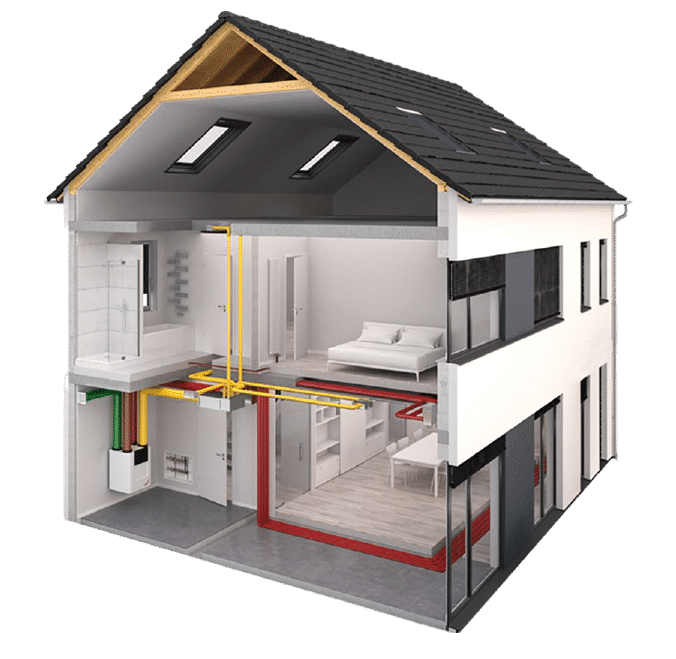How HRV Ensures a Cleaner Indoor Living Environment
How Heat Recovery Ventilation Improves Indoor Air Top Quality and Reduces Energy Costs
Heat Recovery Ventilation (HRV) systems play a crucial duty in boosting indoor air high quality while concurrently reducing power expenses. By effectively trading stale interior air with fresh exterior air, HRVs help preserve suitable moisture and decrease pollutants. Furthermore, their ability to recuperate warmth from outbound air lessens the pressure on heating and cooling systems. As power costs continue to increase, understanding the complete possibility of HRV systems ends up being progressively crucial for house owners and businesses alike.
Recognizing Heat Recovery Ventilation Systems

Heat recovery ventilation (HRV) systems play a crucial function in improving interior air top quality, specifically in modern-day, energy-efficient structures. These systems are created to move warm from the outbound stagnant air to the incoming fresh air, consequently reducing energy loss while keeping suitable temperature degrees inside. HRVs are composed of a warm exchanger, fans, and ductwork, helping with the constant blood circulation of air. By getting rid of indoor pollutants and presenting fresh air, HRVs help to balance moisture levels, protect against mold and mildew growth, and reduce allergens. The performance of HRV systems depends on their capability to recuperate up to 80% of the heat from the tired air, promoting power conservation while making sure a healthy and balanced interior atmosphere. Their combination is vital in attaining sustainable living practices.
The Relevance of Indoor Air Top Quality
Indoor air quality (IAQ) is a crucial element influencing the wellness and well-being of occupants in any kind of setting. Poor IAQ can lead to different wellness issues, including respiratory issues, allergic reactions, and exhaustion. Additionally, it can exacerbate status quo such as asthma. Variables contributing to reduced IAQ consist of pollutants from interior sources like cleaning representatives, mold and mildew, and inadequate ventilation. As a result, maintaining good IAQ is essential for promoting a safe and comfortable living or functioning area. Efficient methods to improve IAQ involve routine monitoring of air quality, correct air flow systems, and decreasing making use of damaging compounds inside your home. By prioritizing IAQ, individuals can assure a healthier environment that fosters efficiency and overall lifestyle.
Energy Effectiveness Conveniences of HRV Solutions
Several home owners and building supervisors are progressively identifying the power efficiency benefits of heat recovery air flow (HRV) systems. By moving warm from exhausted indoor air to incoming fresh air, HRV systems substantially lower the energy required for heating & cooling. This procedure lessens reliance on typical cooling and heating systems, resulting in lower energy costs. Furthermore, HRVs help keep a well balanced indoor environment, stopping excessive home heating or cooling down demands. The ability to recoup as much as 90% of the warmth from outbound air likewise sustains sustainability initiatives by lowering overall power intake. Subsequently, HRV systems contribute not just to set you back financial savings but likewise to a minimized carbon footprint, aligning with the expanding focus on energy-efficient building methods.
Setup and Upkeep Considerations
The efficient implementation of warmth recovery ventilation (HRV) systems requires cautious factor to consider of installment and maintenance variables to assure peak efficiency. Proper positioning of the HRV unit is vital, as it must be installed in an area that maximizes air movement while reducing noise disruption. In addition, ductwork should be properly sized and insulated to avoid power loss. Routine upkeep, consisting of filter replacement and system cleansing, is critical to protect optimal capability and interior air high quality. Proprietors should develop a routine upkeep routine to recognize and address have a peek at these guys prospective issues before they rise. Cooperation with seasoned experts throughout both installation and upkeep stages can improve the long life and performance of HRV systems, inevitably resulting in much better indoor settings and minimized energy costs.
Real-World Applications and Success Stories
Checking out real-world applications of warmth healing ventilation (HRV) systems reveals their significant influence on interior air quality and energy efficiency across various settings. In household structures, homeowners have reported improved air quality, leading to less allergies and breathing issues. Schools executing HRV systems have noted improved trainee concentration and decreased absenteeism due to much better ventilation. Commercial structures, such as workplaces and retail spaces, have actually experienced reduced power expenses and boosted employee efficiency. For example, a business office in a temperate environment attained a 30% reduction in energy costs after installing an HRV system. These success stories demonstrate that HRV modern technology not only adds to much healthier environments however likewise gives concrete financial advantages, making it a beneficial financial investment for numerous industries.
Often Asked Questions
Can HRV Solutions Reduce Allergens in Indoor Air?
The performance of HRV systems in reducing interior allergens largely rests on their capacity to filter and exchange air. HRV Heat Recovery Ventilation. By constantly changing stale air, these systems can significantly reduce allergen levels throughout interior settings

Exactly How Does Humidity Affect HRV System Performance?
Humidity greatly affects HRV system efficiency; high levels can result in condensation, lowering effectiveness, while reduced moisture may improve air exchange. Balancing humidity is essential for excellent operation and preserving indoor air high quality.
Are HRV Equipments Noisy Throughout Procedure?
HRV systems can see this here generate differing noise degrees during operation, depending on their style and installation. Some systems run quietly, while others might produce noticeable sound, specifically at greater air flow settings or when poorly preserved.
What Is the Typical Life-span of an HRV System?

Can HRV Equipments Be Made Use Of in All Environments?
HRV systems can be utilized in numerous environments, however their effectiveness might vary - HRV Heat Recovery Ventilation. In severe temperatures, adjustments or extra systems may be required to have a peek at this site assure excellent performance and convenience while keeping indoor air high quality